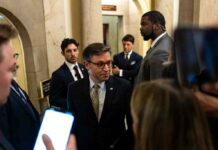AP – With characteristic bravado, Donald Trump has vowed that if voters return him to the White House, “inflation will vanish completely”.
It’s a message tailored for Americans who are still exasperated by the jump in consumer prices that began three and a half years ago.
Yet most mainstream economists said Trump’s policy proposals wouldn’t vanquish inflation. They’d make it worse.
They warn that his plans to impose huge tariffs on imported goods, deport millions of migrant workers and demand a voice in the Federal Reserve’s (Fed) interest rate policies would likely send prices surging.
Sixteen Nobel Prize-winning economists signed a letter in June expressing fear that Trump’s proposals would “reignite” inflation, which has plummeted since peaking at 9.1 per cent in 2022 and is nearly back to the Fed’s two per cent target.
Last month, the Peterson Institute for International Economics predicted that Trump’s policies would drive consumer prices sharply higher two years into his second term.
Peterson’s analysis concluded that inflation, which would otherwise register 1.9 per cent in 2026, would instead jump to between six per cent and 9.3 per cent if Trump’s economic proposals were adopted.

Many economists aren’t thrilled with Vice President Kamala Harris’ economic agenda, either.
They dismiss, for example, her proposal to combat price gouging as an ineffective tool against high grocery prices. But they don’t regard her policies as particularly inflationary.
Moody’s Analytics has estimated that Harris’ policies would leave the inflation outlook virtually unchanged, even if she enjoyed a Democratic majority in both chambers of Congress.
An unfettered Trump, by contrast, would leave prices higher by 1.1 percentage points in 2025 and 0.8 percentage points in 2026.
Taxes on imports – tariffs – are Trump’s go-to economic policy. He argues that tariffs protect American factory jobs from foreign competition and deliver a host of other benefits.
While in office, Trump imposed high tariffs on most Chinese goods. He also raised import taxes on foreign steel and aluminium, washing machines and solar panels.
He has grander plans for a second term: Trump wants to impose a 60-per-cent tariff on all Chinese goods and a “universal” tariff of 10 per cent or 20 per cent on everything else that enters the United States (US). Trump insists that the cost of taxing imported goods is absorbed by the foreign countries. The truth is that US importers pay the tariff – and then typically pass along that cost to consumers in the form of higher prices. Americans themselves end up bearing the cost.
Kimberly Clausing and Mary Lovely of the Peterson Institute have calculated that Trump’s proposed 60 per cent tax on Chinese imports and his high-end 20 per cent tariff on everything else would, in combination, impose an after-tax loss on a typical American household of USD2,600 a year.
The Trump campaign notes that US inflation remained low even as Trump aggressively imposed tariffs as president.But chief economist Mark Zandi at Moody’s Analytics said that the magnitude of Trump’s current tariff proposals has vastly changed the calculations.
“The Trump tariffs in 2018-19 didn’t have as large an impact as the tariffs were only just over USD300 billion in mostly Chinese imports,” he said. “The former president is now talking about tariffs on over USD3 trillion in imported goods.”
And the inflationary backdrop was different during Trump’s first term when the Fed worried that inflation was too low, not too high.



















































